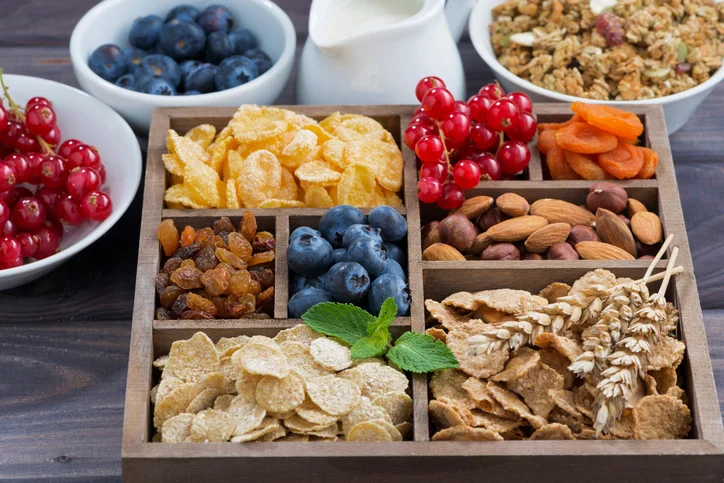Why every snack should contain these two nutrients
/Approximately 95% of Americans snack each day and it is one of the most effective ways to fit in extra nutrients into your diet and to prevent overeating at mealtimes. Since snacks are such a ubiquitous part of most individuals eating routine, choosing healthy options is a must.
Consider a snack sort of like a bridge between meals providing just enough food to tide you over so you don’t come to the table ravenous. A well-timed snack can even out spikes in hunger and provide a much-needed energy boost between meals. However, there are two key nutrients that should be part of every snack – protein and fiber.
A snack composed of a combination of a food(s) containing both protein and fiber will be the best way creating a feeling of fullness without feeling stuffed. And the last thing you want to do is to feel stuffed after eating a snack.
What amount of protein and fiber is needed at a snack? Choose foods containing at least 5 grams of protein per serving and at least 3 grams of fiber per serving.
Why protein should be part of every snack
· There are three macro-nutrients that provide us calories – fat, carbohydrates, and protein. Protein breaks down much slower in the body because it takes longer to break apart the very strong peptide bonds joining the building blocks of protein called amino acids. This slower breakdown generally increases satiety more so than carbohydrates and even fat helping reduce food intake.
· Studies have shown meals or snacks higher in protein are more satiating when compared to meals or snacks lower in protein.
· The type of protein seems to matter when it comes to satiety – animal sources of protein such as dairy and eggs have been shown to lead to reducing appetite for a longer period of time.
· Snacks containing protein help curb cravings giving that all important sense of fullness after eating. When you feel satisfied after eating, you’ll be more likely to stick with a healthy eating plan.
· Protein is also important for preserving lean muscle mass. Including a good source of protein at each snack and meal along with weight-bearing exercise, can keep you from losing excess muscle mass with age.
· Protein needs are based on body weight. The average man and woman require 0.8 grams of protein per kilogram of body weight. Here’s how to figure protein needs:
1. Let’s say a person weighs 176 pounds
2. Convert their weight to kilograms by dividing their weight in pounds by 2.2.
3. 176 divided by 2.2 = 80 kilograms
4. Take 80 x 0.8 = 64 grams of protein needed daily
Why fiber should be part of every snack
· Fiber comes in two forms – soluble and insoluble. Soluble fiber comes from foods such as legumes, oats, blueberries, and apples. This type dissolves into a gel-like substance as it moves through the digestive tract. Insoluble fiber does not form a gel and is the indigestible components found in foods such as whole grains and most vegetables.
· Fiber aids in making you feel full because it moves slowly through your stomach and digestive tract creating that feeling of fullness.
· Studies have shown that when people include more fiber in their diet they tend to have a healthier body weight than those who do not.
· Even though fiber is not really digested, it is vital for increasing stool bulk to decrease constipation, hemorrhoids and diverticulosis. High-fiber foods also help lower blood sugar and blood cholesterol levels fighting diabetes and heart disease.
· The average man requires 38 grams of fiber daily while the average woman requires 25 grams a day.
Examples of snacks containing both a high protein and high-fiber food:
· Carrot/celery sticks or apple slices with peanut butter (8-9 grams of protein in 2 tablespoons).
· Apple slices with walnuts, pistachios, almonds, or cashews (approximately 6 grams of protein in one-fourth to one-half cup).
· Greek yogurt (8-20 grams of protein) with berries or walnuts/sliced almonds
· Hard-boiled egg (6 grams of protein) with whole wheat crackers
· Cottage cheese (12 grams of protein in a one-half cup) paired with fresh/canned fruit or veggies for dipping
· Black bean dip - To make bean dip, drain and rinse canned black beans, mix in chopped onions, minced garlic, chopped cilantro, lime juice, and other favorite seasonings in a blender. Enjoy with veggies such as sliced peppers, carrot or celery sticks or whole wheat crackers
· Edamame or shelled soybeans (one-half cup) contains 8 grams of protein and 4 grams of fiber. Enjoy them also in the pod sprinkled with a touch of sea salt.

